
Looking to improve your gaming performance or just make your controller feel more comfortable? Customizing your gaming controller could be the key. Whether you're a competitive gamer or just enjoy gaming for fun, personalizing your controller can elevate your experience to a whole new level.
In this guide, we explore everything you need to know about how and why gamers customize their controllers, backed by scientific research and user experience studies.
Gaming controllers are the bridge between your hands and the digital world—and small adjustments can make a huge difference. Customization allows gamers to:
Whether you’re tweaking a few settings or completely rebuilding your controller layout, the benefits go beyond aesthetics. Research shows that personalized controllers lead to better accuracy and game performance, especially when the controller layout is tailored to the user’s habits and game genre (Torok et al., 2015).
Customization isn’t just a mechanical enhancement—it has psychological benefits too. Gamers often report higher satisfaction, greater immersion, and even increased loyalty to games when they use personalized setups. According to research, having control over one's controller setup contributes to a deeper sense of ownership and identity in the gaming experience (Teng, 2010). This feeling of ownership enhances engagement and makes the gaming experience more enjoyable.
Here’s a breakdown of the most popular ways gamers customize their controllers, both physically and digitally.
Most modern consoles and gaming platforms offer remapping tools. Players can change which button does what—an essential feature for comfort, preference, and accessibility. It’s particularly useful for switching to layouts you’re more familiar with, such as converting a default Xbox layout to mimic PlayStation-style control.
Especially important for first-person shooter (FPS) and racing game players, adjusting stick sensitivity and dead zones can drastically affect performance. Faster sensitivity means quicker reaction times, while custom dead zones help eliminate drift or unintended input.
The DAREU H105 Mechanical addresses this with its joystick dead zone mode. Featuring a zero dead zone design, it effectively prevents joystick drift and ensures precise control. With a lifespan of 2 million rotations and the ability to easily switch between dead zone modes via the FN key, it offers both durability and flexibility for competitive play.
Advanced controllers often come with physical modifications like trigger stops, which shorten the trigger pull distance. Competitive players use these for faster input response. Customizable back buttons also let you perform actions without removing your thumbs from the sticks—a game-changer in high-pressure situations.
Improving the tactile feel of your controller is another area gamers focus on. Swapping thumbsticks for higher or textured versions, or adding rubber grips to reduce sweat and slippage, can make long gaming sessions more comfortable and controlled.
Innovation in controller design is advancing rapidly. Experimental controllers are pushing boundaries—like using old objects (e.g., radios or rotary phones) as gaming input devices. These alternative controllers provide novelty and enjoyment, even if they don’t always match traditional layouts for performance (Pokorny et al., 2023).
Even more futuristic is the PhysioSense controller, which uses sensors to track your stress level and adjust gameplay feedback—making the experience more adaptive and personalized (ZiYue et al., 2022).
When it comes to customizing gaming controllers, casual and competitive players have distinctly different goals and approaches.
Casual gamers typically focus on comfort, visual appeal, and immersive experience. They might add colorful skins, ergonomic grips, or LED mods that make the controller look and feel more enjoyable during extended play sessions. Their customization efforts are often driven by personal preference and ease of use rather than performance.
The DAREU H101 / H101X is ideal for this, offering a versatile wireless design, ergonomic grip, and customizable RGB lighting—all in a range of stylish colors to suit any setup.
On the other hand, competitive players prioritize functionality, speed, and precision. Their customization choices often include trigger stops for quicker inputs, remappable back buttons for strategic advantages, and sensitivity tuning to optimize response time in high-stakes environments.
These players often follow best practices from professional esports communities or online guides to fine-tune every detail of their setup. While casual gamers enjoy personalization for relaxation and expression, competitive gamers see customization as a tool for winning.
For those serious about competition, the Dareu H105 Mechanical is a top-tier choice. This tri-mode e-sport somatosensory gamepad combines mechanical switches with an adjustable deadzone for unmatched precision and responsiveness. It’s built to deliver professional-grade control, making it the ultimate upgrade for players who play to win.
Both types of gamers benefit from customization, but their motivations reflect their distinct goals—whether it’s maximizing comfort or gaining a performance edge.
Getting started doesn’t have to be intimidating. Here’s a quick-start checklist:
Customizing your controller isn’t just for tech experts or professional players—it’s for anyone looking to make their gameplay more enjoyable, accessible, and personalized. Whether you’re fine-tuning joystick sensitivity for an esports match or simply adding grips to reduce wrist strain, even small changes can have a big impact. Your hands are your weapon. Make sure your gaming controller fits them perfectly.
References:
Ihr Warenkorb ist leer